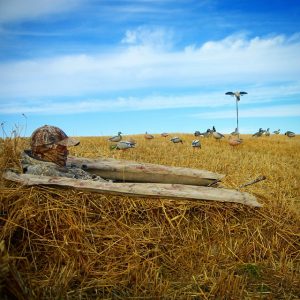Windy Day Waterfowl – Calling Through the Gusts
You awake to hear the familiar whistling sound of the wind howling past your bedroom window. Your wife reminds you “don’t be stupid while chasing those ducks, you stay off the open water and those white capping waves in this wind.” You assure her you’ll be safe, but windy day waterfowl hunting is just too good to pass up. You need to be out in the blind with a north wind like this. Those red-legged ducks will be riding it down right to your spread. So you head out, with the wind blowing 30 MPH, and prepare to return home with chapped cheeks, chapped lips, red cracked and dry eyes, and, hopefully, a full strap of green heads.
With high winds blowing, how should you adjust your calling for ducks and geese? Most of us just plan to pull out our loudest call to “cut through the wind.” But, what is actually happening, and should we be planning to blow the loudest hail calls, or employ some other technique?

Scientific Breakdown
According to wave propagation science, wind affects sound through refraction. When sound is traveling against the wind, the sound waves tend to bend upward. When sound is traveling with the wind, it tends to bend downward. As sound travels, it also spreads out, or dissipates, proportionally with distance.
Now, we should only be concerned about wind affecting our calling when the wind is high (>30 MPH) and the birds are far away (>100 yards). Any less on either of those numbers, and the wind will have a negligible affect on the sound. So, if the wind is blowing 15 and you’re working birds in flooded timber, you probably don’t need the ringing high ball call. However, out on the open fields running traffic for geese, or on the open marsh trying to pull in passing ducks off the nearby river, we need to be aware of the wind and it’s affect on sound.
Adjusting Your Calling Style
The simple answer is this: if you’re blowing a call at birds upwind of you, the sound will be refracted upward, so you should call louder and aim your call under the birds, thereby allowing the wind to bend your sound upward to the ducks. If you’re calling at birds downwind of you, the sound will be refracted downward, so you don’t need to call as loud and you should aim your call directly at or slightly above the birds, thereby allowing the wind to bend your call downward towards the ducks.
Also, keep in mind that wind is often blowing harder at higher altitudes, whereas wind at ground level is constantly being dampened by trees, terrain, and other features. So, if you’re calling at those migrating birds up high on a windy day, you’ll need to aim your sound under the birds and blow it loud. Doing so will allow the wind to refract your sound up to the birds. If those high flying birds are downwind of you, you’ll have a really hard time getting them to hear you in high winds.
So, the next time the wind is howling and you’re watching those ducks at a distance, keep these simple tips in mind. Grab your SBO GT or Traffic Jam, make sure those birds can hear you, and get your gun ready. Windy day waterfowl hunting can provide some fast-moving targets!
Further Reading and References
There are other weather conditions which affect sound enough to change your calling style. Check out our other articles in the series “How Weather Affects Calling”, follow us on Facebook, and subscribe to our newsletter to receive our latest articles directly in your inbox.
References
- http://hyperphysics.phy-astr.gsu.edu/hbase/hframe.html
- https://en.wikibooks.org/wiki/Engineering_Acoustics/Outdoor_Sound_Propagation
- http://www.hk-phy.org/iq/sound_wind/sound_wind_e.html
- http://www.acousticsbydesign.com/acoustics-blog/weather-affects-noise-study.htm
- http://classroom.synonym.com/effect-wind-sound-transmission-23531.html
- http://www.sfu.ca/sonic-studio/handbook/Sound_Propagation.html


